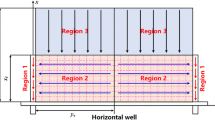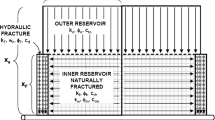This article presents a new ternary-porosity model for evaluating the productivity of horizontal wells in low-permeability gas reservoirs with evenly and unevenly spaced hydraulic fractures. The model accounts for the properties of these fractures. Dimensionless production rate is derived by using the Laplace transform. The effects of hydraulic fractures, natural fractures, and the matrix of the bed on cumulative yield are analyzed systematically. The results show that it is necessary to not only optimize the number of hydraulic fractures and their conductivity but to also include the fracture distribution patterns in the fracture design. The article discusses the parameters that affect the optimum number of hydraulic fractures, including drainage area, the length of the horizontal well, the properties of the natural fractures, matrix permeability, and flow capacity. The model that is derived is rigorous but is also versatile enough for integrating the flow and reservoir characteristics of low-permeability gas reservoirs, and it can be used to optimize the design of hydraulic fracturing.










Similar content being viewed by others
References
J. V. Ilbert and R. D. Barizee, in: SPE Rocky Mountain Petroleum Technology Conference, New Orleans, 2009. SPE 123342.
B. Bagherian, A. Ghalambor, and M. Mahmoudi, in: SPE International Symposium and Exhibition on Formation Damage Control, Louisiana, 2010. SPE 127899.
A. Belyadi., K. Aminian, and S. Ameri, in: SPE Eastern Regional Meeting, West Virginia, 2010. SPE 139082.
A. Belyadi, K. Aminian, and S. Ameri, in: SPE Western Regional Meeting, California, 2012. SPE 153894.
S. Leopoldo, M. Mike, and C. J. Jin, in: SPE Hydraulic Fracturing Technology Conference, Texas, 2013. SPE 163833.
C. Chih-Cheng and R. S. Raghavan, SPE Journal, 2, No. 4, 455-465 (1997)
Raghavan R. S., Chih-Cheng C., Agarwal B., Ibid., 2, No. 3, 235-245 (1997).
E. Ozkan and R. S. Raghavan, SPE Formation Evaluation, 6, No. 3, 359-368 (1991).
Ozkan E., Raghavan R. S. SPE Formation Evaluation. 1991. V. 6. N 3. P. 369–378.
E. Ozkan and R. S. Raghavan, in: Annual Technical Conference and Exhibition, New Orleans, 1991. SPE 28424.
Fujie Sun, Shugang Han, Linsong Cheng, et al., Journal of Southwest Petroleum Institute, 27, No. 1, 32-36 (2005).
Yuguang Zhang, Science Technology and Engineering, 10, No. 12, 2861-2864 (2010).
F. Medeiros, E. Ozkan, and H. Kazemi H. SPE Formation Evaluation, 11, No. 5, 902-911 (2008).
Shuping Wang, Yunquing Shi, Jin Yan Jin, et al., Journal of Daqing Petroleum Institute, 36, No. 3, 67-71 (2012).
M. Brown, E. Ozkan, R. S. Raghavan, et al., in: SPE Annual Technical Conference and Exhibition, New Orleans, 2009. SPE 125043.
M. Brown, E. Ozkan, and R. S. Raghavan, in: SPE Western Regional Meeting, California, 2009.
Xiaodong Wang, Guanghe Li, and Fei Wang., Petroleum Science, 7, No. 3, 367-371 (2010).
A. A., Triple-Porosity Model for Fractured Horizontal Wells. M. S. Thesis. Texas: Texas A&M University, 2010.
V. Camacho and R. S. Raghavan, SPE Formation Evaluation, 1, No. 2, 9-28 (1987).
Shunchu Li and Bingguang Huang, in: Laplace Transform and Bessel Functions and the Theoretical Basis of Well Test Analysis. Petroleum Industry Press, Beijing.
Weibing Zhu, Shunchu Li, and Xu Changxue, Drilling and Production Technology, 31, No. 3, 67-69 (2008)
Shunchu Li, Pengshe Zheng, and Yufei Zhang, Applied Mathematics a Journal of Chinese Universities. 24, No. 2, 234-238 (2009).
Jingjing Guo, Liehui Zhang, and Wang Haitao, Journal of Hydrodynamics, 26, No. 6, 64–72 (2011).
Wei Li, Xiaoping Li, and Shunchu Li, Ibid., 24, No. 3, 332-338 (2012).
R. Bruce, W. R Lucas, J. Henry, et al., SPE Unconventional Gas Conference, Pennsylvania, 2010. SPE 131732.
This research was carried out with the support of the National Priorities Project in the Area of Science and Engineering (N 2011ZX05022-006-004HZ).
Author information
Authors and Affiliations
Additional information
Translated from Khimiya i Tekhnologiya Topliv i Masel, No. 4, pp. 21 – 29, July – August, 2014.
Rights and permissions
About this article
Cite this article
Haitao, L., Junchao, W., Yongqing, W. et al. Generalized Productivity Model for Designing Hydraulic Fractures in Horizontal Wells Located in Naturally Fissured Low-Permeability Gas Reservoirs. Chem Technol Fuels Oils 50, 299–314 (2014). https://doi.org/10.1007/s10553-014-0527-z
Published:
Issue Date:
DOI: https://doi.org/10.1007/s10553-014-0527-z




